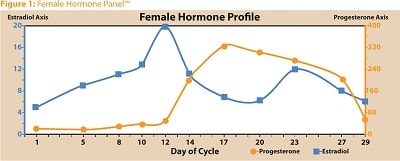Female Hormone Panel™ (FHP™)
The Female Hormone Panel™ (FHP™) is a non-invasive test consisting of 11 saliva specimens collected during specified time periods throughout the menstrual cycle. The ovaries are a major component of the female reproductive cycle and they release hormones in a cyclical manner which is referred to as the menstrual cycle. The Female Hormone Panel™ provides a dynamic mapping of the free fraction levels of Estradiol (E2) and Progesterone (P) throughout one cycle. In addition, the cycle average of Testosterone (T) and DHEA are measured. The Female Hormone Panel™ includes: Hormone Testing Estradiol (x11), Progesterone (x11), cycle average Testosterone and DHEA/DHEA-S, 3 Progesterone production indices, 4 Estradiol production indices, a full cycle P/E ratio graph and an example of a restorative plan. The expanded Female Hormone Panel™ (eFHP™) includes an additional five (5) FSH and five (5) LH measurements.
The Nutrition and Health Center utilizes the leading salivary-based testing and research laboratory in the United States to measure hormones. This method is called, Enzyme Linked Immunosorbent Assay; it measures “free fraction hormone levels,” giving more information than measuring “bound hormone levels.” The commonly used blood and serum hormone tests look only at the level of hormones that are present in a person’s tissues; this is known as “bound hormone levels.” Saliva testing has many advantages over blood testing including:
- Saliva specimen collection does not require a blood draw and there are no risks to you
- Saliva collections are convenient and can be done at work or at home
- When stored properly, saliva samples are stable for several weeks
- With an accuracy of 92-96%, saliva testing is more accurate than blood testing
- The ability to collect more than one specimen which provides more information than a single collection
- Compared to blood testing, saliva testing is also more affordable
- Saliva testing looks at the “unbound hormone levels” also known as “free fraction hormone levels” which are the hormone levels that are available to be used by the body’s tissues. This gives a better idea of the levels of hormones that are actually influencing the tissues, rather than just the level of hormones that are present in the tissues
Why Evaluate Female Hormones?
The human ovary releases its hormones in a cyclical manner, which is referred to as the menstrual cycle. The average cycle is 26-30 days. The timing and pacing of hormone release is governed by GnRH, FSH and LH, hormones from the hypothalamus and pituitary glands in the brain. The two major classes of ovarian hormones released during the menstrual cycle are estrogens and progestogens, also known as the female steroid sex hormones. The major and most active estrogen released is estradiol, while the major progestogen is progesterone.
Applications for the Female Hormone
Panel™ include:
Detection of Luteal Phase Deficit – There are at least three luteal phase-deficit patterns which are characterized by a progesterone/estrogen imbalance. This imbalance is usually associated with PMS, infertility, fibroids and other female hormone-related problems and can be readily detected by our panels.
Hormonal Imbalance and PMS – Many women suffer from hormonal imbalance in the estrogen to progesterone ratio. Our panels can define the hormonal state with exquisite accuracy which, in turn, provides specific insights for appropriate intervention to relieve hormonal imbalance and PMS-related symptoms.
Customized Hormone Therapy – Presently, female hormone therapy is not individualized to the needs of each woman, because current diagnostic tests do not provide sufficient data. Consequently, most women are empirically treated without regard to their individualized physiology and specific needs. The FHP™, for the first time, allows for customized therapy.
Detection and monitoring of:
- Functional infertility
- Influence of diet, exercise and other lifestyle factors on the cycle
- Menstrual problems originating in the brain
- Early pregnancy problems, such as spontaneous miscarriage
- Cycle irregularities, following the use of birth control pills
- Dysmenorrhea (painful and heavy periods)
- Migraine headaches
- Cystic ovarian disease
- Early osteoporosis



